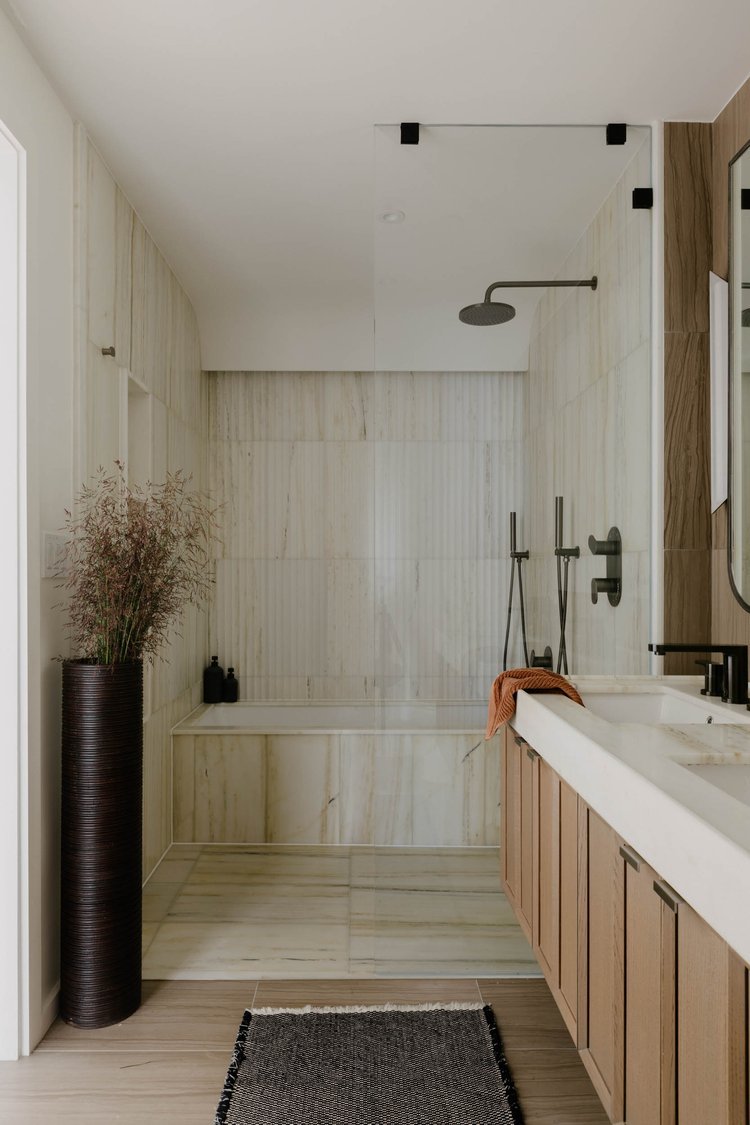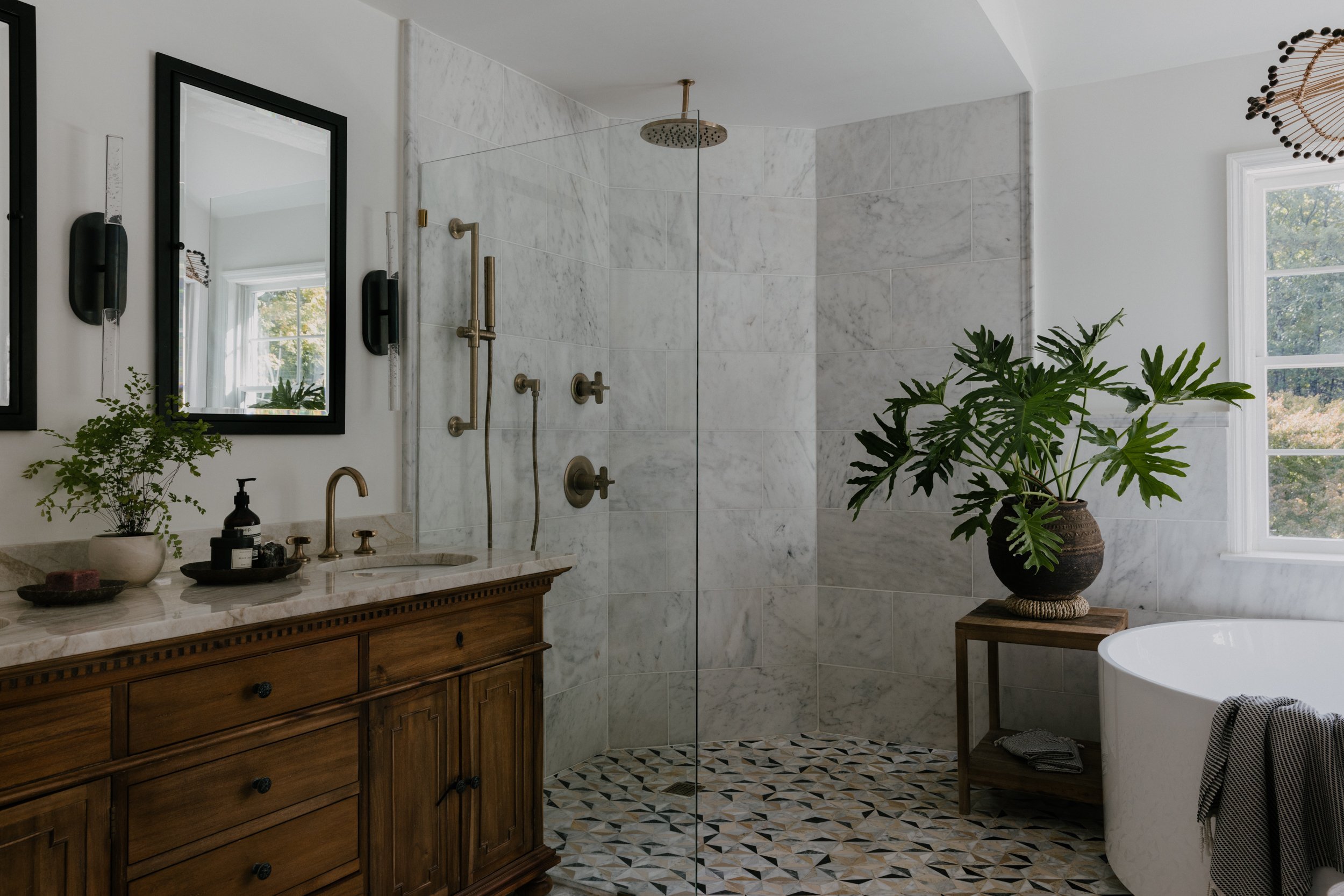Whether you’re remodeling your kitchen, bathroom, or entire home, selecting the right materials and finishes is an important part of the process. But it can also be tricky! Tile is one of those things that seems basic, but there’s a lot more than meets the eye.
From selecting the right style, color, material, shape, and size, there are a lot of factors involved. Understanding the various types of tiles available and what to consider when choosing them is crucial for achieving your desired interior design vision.
That’s why in this post we’re diving into all things related to choosing tile. Keep reading for everything you need to know!
Why Use Tile in Your Home Design
Tile can not only enhance the aesthetics and design of your home, but it offers numerous advantages that make it a popular choice for home design projects:
Durability: Tiles are known for their durability and longevity, making them an excellent investment for high-traffic areas such as kitchens, bathrooms, and entryways. They can withstand daily wear and tear, including spills, stains, and scratches, without losing their beauty or integrity.
Versatility: Available in a wide variety of materials, sizes, patterns, and colors, tiles allow for endless design possibilities. Whether you like a classic, modern, or eclectic look, there’s a tile option to suit your style.
Easy Maintenance: Tiles are relatively easy to clean and maintain, requiring simple regular care to keep them looking great. Depending on the material and finish, tiles may only need sweeping, mopping, or occasional sealing to preserve their appearance and functionality.
Hygiene: Tiles offer hygienic benefits, especially in susceptible to moisture, like bathrooms, laundryrooms, mudrooms, and kitchens. They’re resistant to water, mold, and mildew, making them an ideal choice for maintaining a clean and healthy living environment.
Eco-Friendly: Many tile materials, such as ceramic, porcelain, and natural stone, are eco-friendly options that are made from natural materials and can be recycled or reused. Additionally, tiles can help reduce energy consumption by providing insulation, keeping your home cooler in the summer and warmer in the winter.
Most Common Types of Tile Materials
Before you start looking at tile samples, you’ll want to familiarize yourself with the different types of materials available, so you can determine which kind will work best for your aesthetic preferences, needs, and lifestyle.
Ceramic Tiles
Ceramic tiles are a versatile option available in a wide range of colors, patterns, and sizes. They’re popular for their affordability and ease of maintenance. However, they may not be as durable as other options and can be prone to chipping or cracking, especially in high-traffic areas. We recommend using ceramic tiles in low to medium-traffic areas or for a backsplash or wall tile.
Porcelain Tiles
Porcelain tiles are engineered to be highly durable and resistant to stains, scratches, and moisture. They’re a great choice for high-traffic areas like entryways, kitchens, and bathrooms. Porcelain tiles come in various designs, including replicas of natural materials like stone and wood, offering the look of luxury without the maintenance or high price tag.
Natural Stone Tiles
Natural stone tiles, like marble, travertine, limestone, and slate, exude a timeless sophistication. Each one is unique, featuring distinctive variations in color, veining, and texture. While natural stone adds a luxurious touch to any space, it’s not as durable as porcelain and requires sealing to protect it from staining or etching from spills and moisture.
Terracotta and Quarry Tiles
Terracotta and Quarry tiles offer a rustic charm and warmth that adds character to any space. Made from fired clay, these tiles feature earthy tones and natural variations, creating a cozy and inviting ambiance. They’re durable and work for both indoor and outdoor spaces, making them ideal for floors, patios, and walkways.
What Factors to Consider When Selecting Tile
Before diving into the world of tile selection, it’s crucial to consider several key factors to ensure that you choose the right tiles for your home. Here’s what to keep in mind:
Location and Use
The intended use of the tile and the location where it will be installed are critical factors to consider. For example, floor tiles should be durable and slip-resistant to withstand heavy foot traffic, while wall tiles can prioritize aesthetics and ease of cleaning. In wet areas like bathrooms and kitchens, it’s essential to choose tiles with low water absorption to prevent moisture-related issues like mold and mildew.
Tile Hardness Class
When browsing different tile choices, tile hardness is an important factor to consider. Tile hardness is measured on Moh’s scale, and class ratings determine the tile’s ability to withstand wear and tear, foot traffic, stains, scratches, and weather conditions.
- Class 1: Ideal only for walls.
- Class 2: Suitable only for walls and light traffic rooms.
- Class 3: Can be installed in areas with light to medium foot traffic. Suitable for walls, countertops, and rooms with fewer footfalls. Not recommended for outdoor use or places with high traffic.
- Class 4: These tiles are both beautiful and functional, making them suitable for almost all home areas with medium to high traffic.
- Class 5: Best choice for high to super high traffic areas. Tiles of class 5 are suitable for use in homes, offices, and commercial spaces both indoors and outdoors.
Consider the tile hardness class to ensure that the chosen tiles can withstand the intended level of foot traffic and environmental conditions.
Tile Porosity
Another essential aspect to consider when selecting tiles for your home is the tiles’ porosity, which refers to the ratio of air holes to solids and determines how much water the tile absorbs.
- Non-vitreous: These tiles have a low density and a water absorption rate of over 7.0 percent. Due to their high porosity, they are not suitable for flooring.
- Semi-vitreous: Tiles in this category have medium density with a water absorption rate of 3-7 percent. Suitable for light traffic areas.
- Vitreous: Tiles with a water absorption rate of more than 0.5 but less than 3.0 percent are denser and long-lasting.
- Impervious: These tiles boast a water absorption rate of less than 0.5 percent, making them exceptionally durable and dense. Porcelain tiles are usually found in this category and are ideal for moisture-prone areas.
Go for tiles with lower water absorption rates to prolong their lifespan, particularly in areas susceptible to moisture like bathrooms, kitchens, and laundry rooms. Before making your selection, verify the tiles’ porosity ratings to confirm their suitability for your needs.

Style and Aesthetics
The style and aesthetic appeal of the tile plays a significant role in shaping the overall look and feel of your space. Consider factors such as color palette, pattern, texture, and size to create visual interest and harmony. No matter your aesthetic preferences, the right tile can elevate the ambiance and personality of your room.
Tips for the Selection Process
Now that you know more about the benefits of tile, different materials, and what factors to consider when choosing a tile, here are tips to help you navigate the selection process with ease:
Gather Inspiration
Browse design magazines, websites, and social media to gather inspiration for your tile project. Create a mood board or Pinterest board to collect images of tiles, color schemes, and design ideas that appeal to you.
Consider the Overall Design Scheme
Ensure that the chosen tile complements the overall design scheme of your space, including existing elements such as furniture, fixtures, and finishes. Pay attention to factors such as color coordination, texture, and scale to create a cohesive and harmonious look.
Don’t Forget the Grout
Choose the right grout color and type to complement your tile selection and enhance the overall appearance of your space. Consider factors such as durability, stain resistance, and ease of cleaning when selecting grout to achieve the desired aesthetic and functionality.

Bring in the Experts
When it comes to tile selection, layout, and professional installation hiring an interior designer can make all the difference. Here’s how we’ll take care of everything for you:
Tile Selection
We’ll guide you through the process of selecting the perfect tiles for your project, considering factors such as style, material, durability, and budget. With our expertise, we’ll help you choose tiles that not only complement your design vision but also meet your practical needs.
Tile Layout Planning
Our team will carefully plan the layout of your tiles to minimize wastage and achieve a balanced and visually appealing result. Considering factors such as tile size, pattern, and grout lines, we’ll create symmetry and flow throughout the space.
Professional Installation
We’ll ensure that your tiles are installed correctly and securely by choosing experienced and reputable installers. Proper installation is crucial for preventing issues such as unevenness, cracking, and water damage, which can compromise the integrity and longevity of your tile project.
When collaborating with AHG Interiors, you can count on us to offer valuable insights and recommendations based on our extensive expertise and experience. We’ll help you navigate the vast array of options available and make informed decisions that suit your specific needs and preferences.
Ready to get started? Get in touch with us today!


